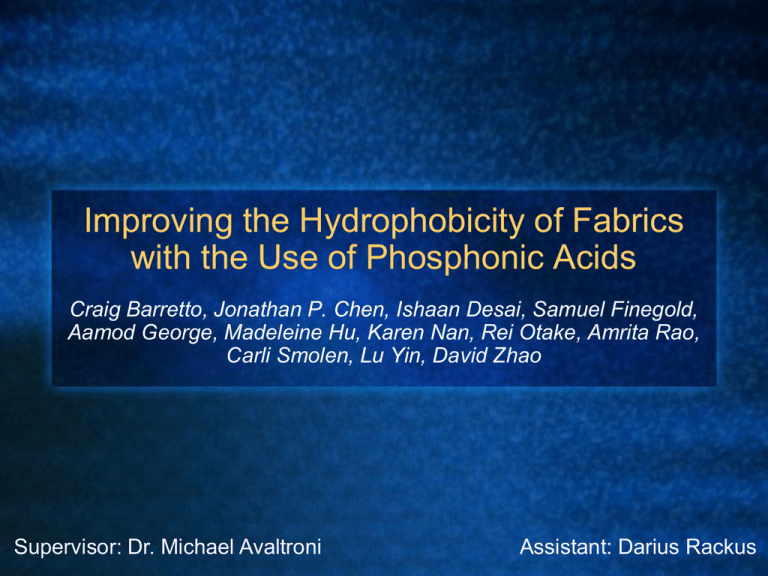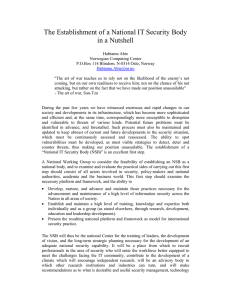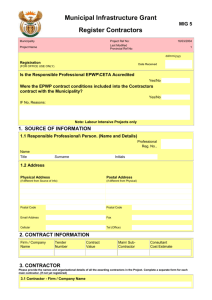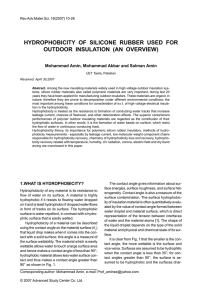TeflonTitle
advertisement

Improving the Hydrophobicity of Fabrics with the Use of Phosphonic Acids Craig Barretto, Jonathan P. Chen, Ishaan Desai, Samuel Finegold, Aamod George, Madeleine Hu, Karen Nan, Rei Otake, Amrita Rao, Carli Smolen, Lu Yin, David Zhao Supervisor: Dr. Michael Avaltroni Assistant: Darius Rackus Teflon® Teflon (PTFE) widely known and used hydrophobic substance Resistant to many extreme conditions, low µ value Tends to flake off, potentially carcinogenic Rain-X® Polydimethylsiloxane (PDMS) Sprayed on Disadvantage: Not permanent, weakens under external pressures n Si(CH3)2Cl2 + n H2O → [Si(CH3)2O]n + 2n HCl http://en.wikipedia.org/wiki/File:Water_beads_on_glass_surface.jpg http://en.wikipedia.org/wiki/File:Silicone-3D-vdW.png http://en.wikipedia.org/wiki/File:Pdms.png Scotchgard™ Treated fabrics become water- and stain-resistant Original formula shown to the right Was shown to be carcinogenic Main ingredient was changed to PFBS Phosphonic Acids Self-Assembled Monolayers (SAM) Structure & Function Chain Lengths ODPA HPA DPA DDPA TDPA HDPA (C6) (C14) (C12) (C16) (C18) OPA (C10) (C8) Hydrophobicity Hydrophobic molecules usually non-polar Water beads from cohesion and hydrogen bonds Surface and water share least amount of area θ Hydrophobic θ Hydrophilic Surface Energy Lower surface energy indicates greater hydrophobicity Relationship between contact angle and surface energy described by Young's Equation θc Nylon-Spandex Blend (NSB) •Nylon is a polyamide of amide linkages •Spandex is an elastic, synthetic fiber •85% nylon, 15% spandex www.chemistryexplained.com/Ny-Pi/Nylon.html Purpose and Hypothesis Optimal phosphonic acid and procedure to coat fabric Increase hydrophobicity Speed up binding process Develop more hydrophobic swimwear http://1.bp.blogspot.com/_ouC92wvILSw/SIFspwmW_BI/AAAAAAAACcY/mYej0D2fYMg/s400/Natural+water+drop+in+the+leaf.jpg Preliminary Tests on NSB Qualitative hydrophobicity test Heat resistance tests: Conventional oven, iron, microwave, heat gun Tests to see how NSB handled the solution NSB being ironed www.asia.ru/images/target/photo/51646912/Steam_Iron.jpg Preliminary Tests on NSB Qualitative hydrophobicity test Heat resistance tests: Conventional oven, iron, microwave, heat gun Tests to see how NSB handled the solution toluene upload.wikimedia.org/wikipedia/commons/e/e8/Ethanol-structure.svg upload.wikimedia.org/wikipedia/commons/c/c3/Beaker.svg ethanol Chain Length Tests on Glass Slides Solution 3 dropped on and spread heating methods for dehydration Contact angles measured NSB Hydrophobicity Dipped 3 in solution then air dried heating methods for dehydration Contact angles measured Cotton Testing Procedure Dipped in ODPA and air dried Heated using iron and microwave Six coatings applied Contact angles measured Exposure Tests Tests Washing Machine Chlorinated Water Deionized Water Control C18 3 heating methods www.toondoo.com/cartoon/557143 Average Contact Angle (degrees) Contact Angles on Coated Glass Samples 120 100 80 Glass Results 60 40 20 0 Control HPA (C6) OPA (C8) DPA (C10) DDPA TDPA HDPA ODPA (C12) (C14) (C16) (C18) Chain Length Average Contact Angle (degrees) Contact Angles on Coated NSB Samples 145 140 135 130 125 120 115 110 105 100 NSB Results Microwave Iron Oven Phosphonic Acid ( Carbon Chain Length) Comparison of Heating Application Methods 128 126 124 Contact Angle (Degrees) Average Contact Angle (Degrees) 130 122 120 Comparison of Effectiveness of Drying Methods 118 116 114 112 110 Microwave Iron Heat Application Method Oven Exposure Tests on NSB- Results Contrasted with expectation Hydrophobicity higher after tests Control showed most decrease in hydrophobicity Theories Residue from detergent Reaction with surface Surface cleaning 140 Contact Angles on Coated Cotton Samples 120 Contact Angle (°) 100 80 Microwave 60 Iron 40 20 0 Control C18 Chain Length Future Work More samples to confirm findings More chain lengths used for exposure tests, eg. C-12 and C-14 (worked best on glass) Multiple coatings to one surface to determine its effects Different surfaces Conclusion Based on the results obtained from this project, it can be concluded that the physical properties of a surface can be permanently altered to increase the hydrophobicity of the surface. Acknowledgements Thanks to: Dr. Michael Avaltroni Darius Rackus Dr. David Miyamoto Ramé-Hart Instrument Company John and Laura Overdeck Sponsors of NJGSS 2010 Program Bayer HealthCare Bristol-Myers Squibb Novartis Questions?











